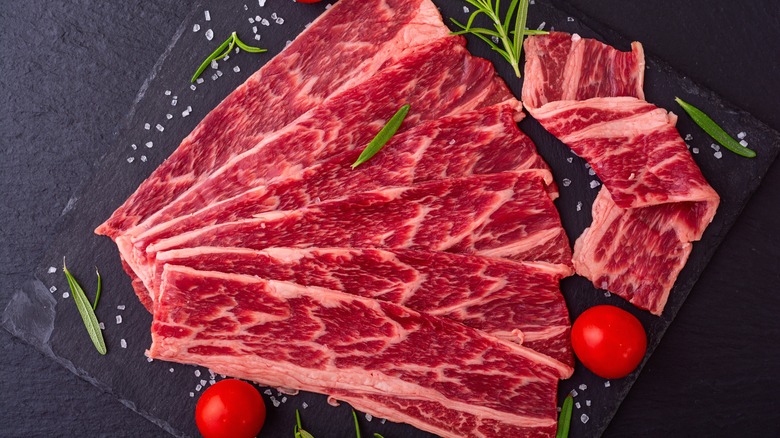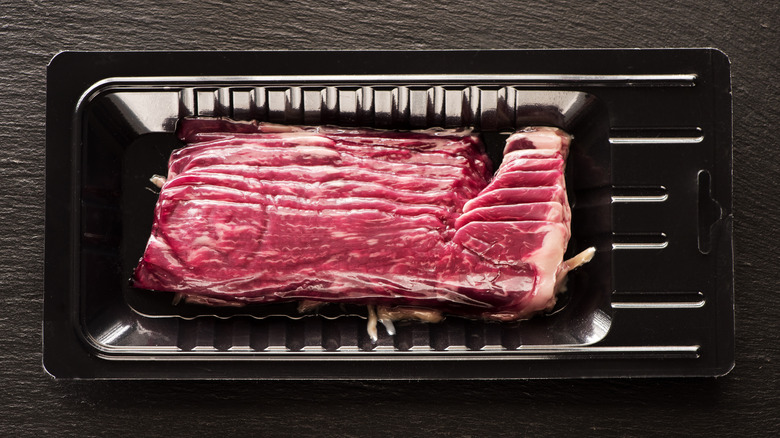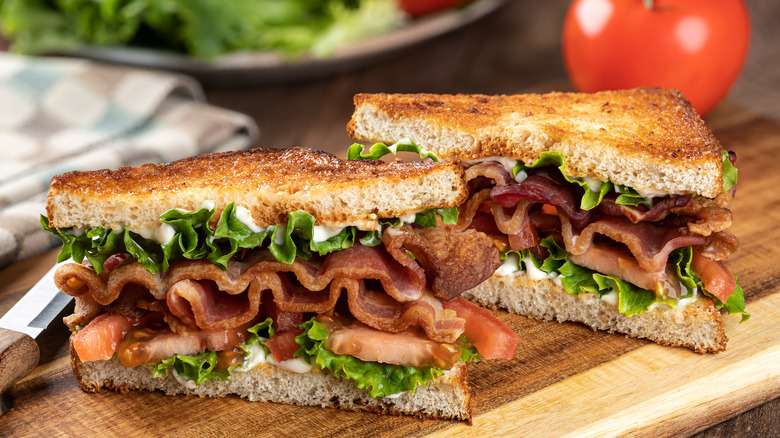Does Beef Bacon Taste Any Different From The Classic Pork Version?
Whether you're making a classic club sandwich or a protein-infused pot of Southern-style pinto beans, bacon is a delicious protein that fills out many different recipes. Traditional bacon is typically derived from pork, but it's not the only variety on the market. But we're not talking about turkey bacon. We're talking about meaty, hearty beef bacon. Beef bacon may be similar to its pork counterpart, but does its flavor differ?
Like pork varieties, beef bacon is thinly-sliced, cured, and smoked meat sourced from cow belly. However, it's occasionally sourced from brisket or round cuts. Because both types of bacon are red meat products, which tend to have deeply savory notes, the differences in flavor are marginal. However, beef bacon flaunts a richer, deeper, and more pronounced red meat flavor. Pork bacon, on the other hand, can have a slightly lighter, milder taste with surprisingly sweet nuances. Due to the curing process, each type of bacon is smoky and salty.
If you can't imagine what that's like, think about how a thick cut of steak compares to a seared pork chop. Both are unmistakably meaty, but the beef dish has a slightly more concentrated and formidable flavor.
How to cook beef bacon
Unlike beef bacon, which has a leaner texture, pork varieties flaunt a fattier quality, facilitating a crispier finish. However, beef bacon can be cooked in all the same ways as its pork counterpart and isn't resistant to developing a good crunch.
Pan-searing is a tried-and-true bacon-cooking method that works equally well on beef bacon as pork. Simply heat a skillet over medium heat and cook the beef bacon slices, turning occasionally, until they're evenly cooked and crispy but never burnt. To bolster its smoky essence, you can also cook beef bacon on the grill. For a more hands-off approach, oven-bake beef bacon at around 400 degrees Fahrenheit, flipping the slices halfway through. The baking process should take around 10 minutes. For an even quicker method that works twice as fast as a conventional oven, you can also air-fry beef bacon. Because it's been smoked and cured and is already rich with a dense umami flavor, there's no need to add extra seasonings to the strips.
Pairing beef bacon
Despite their differences, beef and pork bacon aren't as dissimilar as they sound. They have kindred flavors, share cooking methods, and, conveniently enough, complement many of the same dishes and ingredients.
Beef bacon is a great addition to traditional breakfast fare, pairing well with pork bacon's best friend, eggs. Whether crushed over a scramble, stuffed into a biscuit sandwich, or folded into an omelet, beef bacon adds a dense, savory edge to the eggs' creamy, buttery taste. For lunch, beef bacon is a hearty alternative to pork varieties in a classic BLT, bringing a markedly meaty contrast to the epicenter of the zippy, garden-fresh sandwich. Of course, you can never go wrong with a beef bacon-studded Cobb salad.
Additionally, beef bacon is a unique addition to pasta dishes, bringing virility to vibrant, herb-kissed tomato-based sauces or lush, creamy white sauces. Don't hesitate to use beef bacon as a jacket for gameday-approved, stuffed jalapeno poppers or as a crunchy way to double up on meat in your favorite burger recipe. Although there are many types of bacon not derived from pork, beef bacon is rising in popularity, which makes it easy to access and all the more intriguing to incorporate into your meal rotation.


